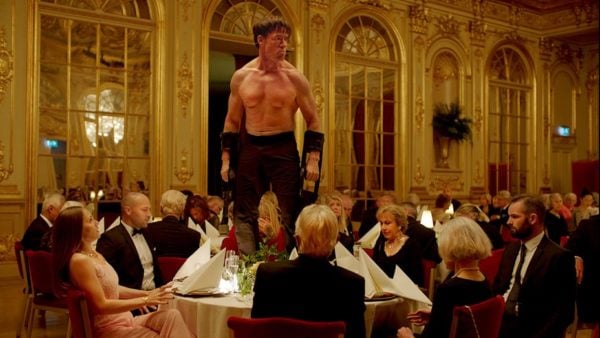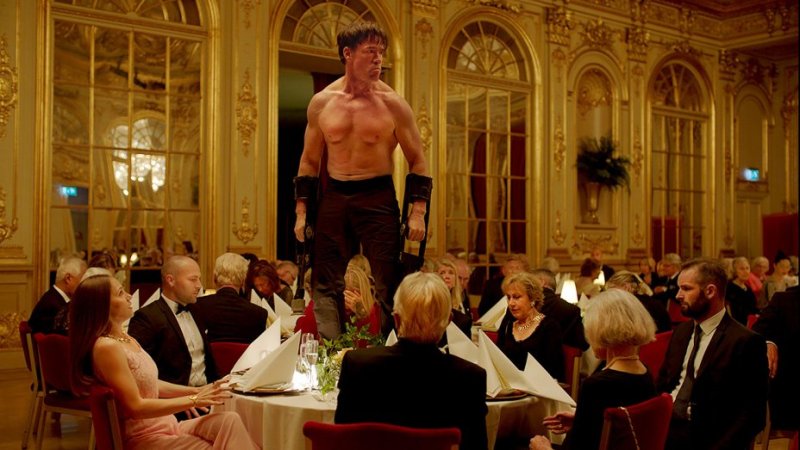
“If we place an object in the museum — for instance, if we took your bag and placed it here, would that make it art?” Christian, a mature but hip (his red-rimmed glasses, for example) curator of a respected art museum in Sweden, poses this question to a blonde American journalist with whom he will consequently sleep. It’s not an unfamiliar topic to us; in fact, whether any object can be proclaimed as art has been dealt by Dadaists such as Marcel Duchamp since the early 1900s. So why does director Ruben Östlund bother to re-kindle the age-old question?
The Square is the first purchase from an Argentinian artist after a donation of 80 million kronor to the museum, but at first sight it’s quite unassuming. Brick tiles demarcated by a string of white LED lights and a label that states “The Square is a sanctuary of trust and caring where everyone shares equal rights and obligations” make you wonder just how far the often the banal nature of postmodernism can be stretched. Without a doubt, The Square is certainly one to push the boundaries. This is one of the many ways that the Palme D’Or winner pokes fun at itself and the modern art society, including the million dollar what-is-art question.
Stranger things have not happened to art than within this satirical Swedish movie. A magnificent bronze sculpture is beheaded after a construction mishap; an art installation of gravel is swept up by the vacuum; a blonde girl is blown to pieces in a promotion video. Indeed, this idiosyncratic approach has attracted the attention of many critics. To discuss further how “The Square” treats art, or the notion of art, would however be a travesty. The film flirts with art here and there, but more artful is the way that the film stirs moral sense of duty within us.
“Ask for help, and help will come” is the mantra attached to The Square. If you’re inside The Square and plead for help, some good Samaritan is obligated to help you. On the streets of Stockholm are supplicants asking for money or some recognition towards the question “Do you want to save a human life?”, all standing inside an invisible square. No one gives a hand, or an eye, to them. It’s a common sight in crowded metropolitan cities and a bit of a trope of the uncaring, busy-footed city dweller. Christian is one of the apathetic passersby; when he encounters a hysterical woman supposedly in threat of her life, he seems more impatient than concerned. We, too, might recognize ourselves on the screen. Could The Square be a cure-all to this problem?
The movie “The Square” attempts to be. Oftentimes, characters are spoken to by those who are off-screen, while within the rectangular movie screen — another Square — the characters look helplessly at the audience. This intensifies in one inflammatory scene, where a female interviewer for an art panel is sporadically called off with vulgar insults by a faceless perpetrator. The audience inside the screen is silent; the audience outside the screen shifts in their seats, wanting to help but unable to. A relay of What Would You Do type of situations occur, and we are left constantly prodding ourselves and our duty towards other human beings. Before an intense art performance starts, we’re told “Do not show weakness … if you do, you will be hunted down. If you don’t, someone else will be the prey.” The last line stings but provides relief at the same time. Our selfishness — and the highbrow art society’s selfishness (donating 80 million kronor to a museum? How many homeless people would that feed?) — is exposed to “The Square” and as we leave the theater, to the world.
The movie also asks who we feel sympathy for and who we don’t. A blonde homeless girl is chosen to be the victim over, say, an aged non-white homeless man who is more representative of the homeless population, for a video meant to generate shock and sympathy. There’s also a surprising switch of positions within The (invisible) Square when Christian entreats a beggar, who is usually the one inside The Square, to watch over his children and his shopping bags. When Christian is left stripped of his powerful position after a series of complications, he finally admits in a cheesy video message that he once held unfair bias towards those in the lower class — only to move on to theorize about societal problems without actually lending a hand, of course.
In the last scenes we realize that Christian cannot absolve his guilt and responsibility towards the underprivileged just by winning forgiveness from one irritated boy, that it’s a process, perhaps for the rest of his life. And it’s the same for us — it’s a rare realization of humanity in the genre of largely bleak, pessimistic art films we’ve come across recently. As Christian drives away down a tunnel, a blend of gasping, whispering voices sing in unison, balancing on each other and soaring to new highs. The screen fades black.
Contact Elaine Kim at elainekm ‘at’ stanford.edu.
